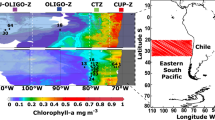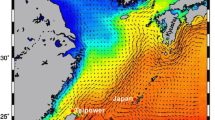Abstract
Copepods of the genus Acartia dominate zooplankton assemblages in northwestern Atlantic estuaries, many of which originated after the last glacial maximum 10,000–18,000 years ago. Acartia hudsonica occurs, at least seasonally, in estuaries from Chesapeake Bay to Labrador/Newfoundland. We sequenced the mitochondrial gene Cytochrome B (CytB) of 75 individuals of A. hudsonica from 26 estuaries from New Jersey to Maine, covering four biogeographic regions, and 11 individuals of Acartia tonsa from four of these estuaries in the southern part of the sampling range. A. hudsonica exhibited exceptionally high intraspecific DNA sequence variation. Uncorrected p-distances between sequences ranged from 0.3 to 31%. Five highly divergent sequence groups differed in frequencies across populations and biogeographic regions. One sequence group dominated northern localities, and two sequence groups were found at intermediate to high frequencies in two southern biogeographic regions. Ages of the sequence groups were estimated to be 11, 13, 30, and 37 million years, by applying a molecular clock calibrated by divergence in Alpheus snapping shrimps across the Isthmus of Panama. These ages were compared with independent biogeographic paleoceanographic data, and may have coincided with periods of global climate change over the past 40 MY.


Similar content being viewed by others
References
Altschul, S. F., W. Gish, W. Miller, E. W. Meyers & D. J. Lipman, 1990. Basic local alignment search tool. Journal of Molecular Biology 215: 403–410.
Anderson, D. M., B. A. Keafer, W. R. Geyer, R. P. Signell & T. C. Loder, 2005. Toxic Alexandrium blooms in the western Gulf of Maine: the plume advection hypothesis revisited. Limnology & Oceanography 50: 328–345.
Bradford, J. M., 1976. Partial revision of the Acartia subgenus Acartiura (Copepoda: Calanoida: Acartiidae). New Zealand Journal of Marine and Freshwater Research 10: 159–202.
Bucklin, A., B. W. Frost & T. D. Kocher, 1992. DNA sequence variation of the mitochondrial 16S rRNA in Calanus (Copepoda: Calanoida): intraspecific and interspecific patterns. Molecular Marine Biology & Biotechnology 1: 397–407.
Bucklin, A., B. W. Frost & T. D. Kocher, 1995. Molecular systematics of six Calanus and three Metridia species (Calanoida: Copepoda). Marine Biology 121: 655–664.
Bucklin, A., R. C. Sundt & G. Dahle, 1996. The population genetics of Calanus finmarchicus in the North Atlantic. Ophelia 44: 29–45.
Bucklin, A., S. B. Smolenack, A. M. Bentley & P. H. Wiebe, 1997. Gene flow patterns of the euphausiid, Meganyctiphanes norvegica, in the NW Atlantic based on mtDNA sequences for cytochrome b and cytochrome oxidase I. Journal of Plankton Research 19: 1763–1781.
Bucklin, A., M. Guarnieri, R. S. Hill, A. M. Bentley & S. Kaartvedt, 1999. Taxonomic and systematic assessment of planktonic copepods using mitochondrial COI sequence variation and competitive, species-specific PCR. In Zehr, J. P. & M. A. Voytek (eds), Molecular Ecology of Aquatic Communities. Hydrobiologia 401: 239–254.
Bucklin, A., B. W. Frost, J. Bradford-Grieve, L. D. Allen & N. J. Copley, 2003. Molecular systematic and phylogenetic assessment of 34 calanoid copepod species of the Calanidae and Clausocalanidae. Marine Biology 142: 333–343.
Caudill, C. C. & A. Bucklin, 2004. Molecular phylogeography and evolutionary history of the estuarine copepod, Acartia tonsa, on the northwest Atlantic coast. Hydrobiologia 511: 91–102.
Chen, G. & M. P. Hare, 2008. Cryptic ecological diversification of a planktonic estuarine copepod, Acartia tonsa. Molecular Ecology 17: 1451–1468.
Citarella, G., 1982. Le zooplankton de la baie de Shédiac (Nouveau-Brunswick). Journal of Plankton Research 4: 791–812.
Davis, M. B. & R. G. Shaw, 2001. Range shifts and adaptive responses to Quaternary climate change. Science 292: 673–679.
Donoghue, P. C. J. & M. Benton, 2007. Rocks and clocks: calibrating the Tree of Life using fossils and molecules. Trends in Ecology and Evolution 22: 424–431.
Durbin, E. G., M. C. Casas, T. A. Rynearson & D. C. Smith, 2008. Measurement of copepod predation on nauplii using a qPCR of the cytochrome oxidase I gene. Marine Biology 153: 699–707.
Ekman, S., 1953. Zoogeography of the Sea. Sidgwick and Jackson, London.
Eldrett, J. S., I. C. Harding, P. A. Wilson, E. Butler & A. P. Roberts, 2007. Continental ice in Greenland during the Eocene and Oligocene. Nature 466: 176–179.
Excoffier, L., P. E. Smouse & J. M. Quattro, 1992. Analysis of molecular variance inferred from metric distances among DNA haplotypes: application to human mitochondrial DNA restriction data. Genetics 131: 479–491.
Excoffier, L., G. Laval & S. Schneider, 2005. Arlequin ver. 3.0: an integrated software package for population genetics data analysis. Evolutionary Bioinformatics Online 1: 47–50.
Felsenstein, J., 1985. Confidence limits on phylogenies: an approach using the bootstrap. Evolution 39: 783–791.
Goetze, E. & J. Bradford-Grieve, 2005. Genetic and morphological description of Eucalanus spinifer T. Scott, 1894 (Calanoida: Eucalanidae), a circumglobal sister species of the copepod E. hyalinus s.s. (Claus, 1866). Progress in Oceanography 65: 55–87.
Graur, D. & W. Martin, 2004. Reading the entrails of chickens: molecular timescales of evolution and the illusion of precision. Trends in Genetics 20: 80–86.
Hickerson, M. J., M. A. Gilchrist & N. Takebayashi, 2003. Calibrating a molecular clock from phylogeographic data: moments and likelihood estimators. Evolution 57: 2216–2225.
Ho, S. Y. W. & G. Larson, 2006. Molecular clocks: when times are a-changin’. Trends in Genetics 22: 79–83.
Knowlton, N. & L. A. Weigt, 1998. New dates and new rates for divergence across the Isthmus of Panama. Proceedings of the Royal Society of London Series B 265: 2257–2263.
Kumar, S., K. Tamura & M. Nei, 2004. MEGA3: integrated software for Molecular Evolutionary Genetics Analysis and sequence alignment. Briefings in Bioinformatics 5: 150–163.
Lambeck, K. & J. Chappell, 2001. Sea level change through the last glacial cycle. Science 292: 679–686.
Lee, W. Y. & B. J. McAlice, 1979. Seasonal succession and breeding cycles of three species of Acartia (Copepoda: Calanoida) in a Maine estuary. Estuaries 2: 228–235.
Machida, R. J., M. U. Miya, M. Nishida & S. Nishida, 2004. Large-scale gene arrangements in the mitochondrial genomes of two calanoid copepods Eucalanus bungii and Neocalanus cristatus (Crustacea), with notes on new versatile primers for the srRNA and COI genes. Gene 332: 71–78.
Maddison, D. R. & W. P. Maddison, 2000. MacClade: Analysis of Phylogeny and Character Evolution, Version 4.0. Sinauer Associates, Sunderland, MA.
Marcus, N. H., R. V. Lutz, W. Burnett & P. Cable, 1994. Age, viability, and vertical distribution of zooplankton resting eggs from an anoxic basin: evidence of an egg bank. Limnology & Oceanography 39: 154–158.
McAlice, B. J., 1981. On the post-glacial history of Acartia tonsa (Copepoda: Calanoida) in the Gulf of Maine and the Gulf of St. Lawrence. Marine Biology 64: 267–272.
Merritt, T. J. S., L. Shi, M. C. Case, M. A. Rex, R. J. Etter & J. M. Quattro, 1998. “Universal” cytochrome b primers facilitate intraspecific studies in molluscan taxa. Molecular Marine Biology & Biotechnology 7: 7–11.
Nei, M. & T. Gojobori, 1985. Simple methods for estimating the numbers of synonymous and nonsynonymous nucleotide substitutions. Molecular Biology and Evolution 3: 418–426.
Papadopoulos, L. N., K. T. C. A. Peijnenburg & P. C. Luttikhuizen, 2005. Phylogeography of the calanoid copepods Calanus helgolandicus and C. euxinus suggests Pleistocene divergences between Atlantic, Mediterranean, and Black Sea populations. Marine Biology 147: 1353–1365.
Posada, D. & K. A. Crandall, 1998. Modeltest: testing the model of DNA substitution. Bioinformatics 14: 817–819.
Pulquerio, M. J. F. & R. A. Nichols, 2006. Dates from the molecular clock: how wrong can we be? Trends in Ecology and Evolution 22: 180–184.
Ronquist, F. & J. P. Huelsenbeck, 2003. MrBayes 3: Bayesian phylogenetic inference under mixed models. Bioinformatics 19: 1572–1574.
Rozas, J., J. C. Sánchez-DelBarrio, X. Messeguer & R. Rozas, 2003. DnaSP, DNA polymorphism analyses by the coalescent and other methods. Bioinformatics 19: 2496–2497.
Schizas, N. V., G. T. Street, B. C. Coull, G. T. Chandler & J. M. Quattro, 1999. Molecular population structure of the benthic copepod Microarthridion littorale along the Southeastern and Gulf coasts of the United States. Marine Biology 135: 399–405.
Sullivan, B. K., J. H. Costello & D. Van Keuren, 2007. Seasonality of the copepods Acartia hudsonica and Acartia tonsa in Narragansett Bay, RI, USA during a period of climate change. Estuarine Coastal Shelf Science 73: 259–267.
Swofford, D. L., 2003. PAUP*: Phylogenetic Analysis Using Parsimony (*and Other Methods), Version 4. Sinauer Associates, Sunderland, MA.
Tester, P. A. & J. T. Turner, 1991. Why is Acartia tonsa restricted to estuarine habitats? Proceedings of the 4th International Copepod Conference, Bulletin of the Plankton Society of Japan, Special Volume 603–611.
Turner, J. T., 1981. Latitudinal patterns of calanoid and cyclopoid copepod diversity in estuarine waters of eastern North America. Journal of Biogeography 8: 369–382.
Turner, J. T., 1994. Planktonic copepods of Boston Harbor, Massachusetts Bay and Cape Cod Bay, 1992. In Ferrari, F. D. & B. P. Bradley (eds), Ecology and Morphology of Copepods. Proceedings of the 5th International Conference on Copepoda, Baltimore, MD, June 6–12, 1993. Hydrobiologia 292/293: 405–413.
Weir, B. S., 1996. Genetic Data Analysis II. Sinauer Associates, Sunderland, MA.
Welch, J. J. & L. Bromham, 2005. Molecular dating when rates vary. Trends in Ecology and Evolution 20: 320–327.
Acknowledgments
This project was partially funded by a NSF-EPSCoR grant awarded to NVS. DNA sequencing was performed in the Sequencing and Genotyping facility of the University of Puerto Rico-Río Piedras, which is supported in part by NCRR AABRE Grant #P20 RR16470, NIH-SCORE Grant #S06GM08102, the University of Puerto Rico Biology Department, and NSFCREST Grant #0206200.
Author information
Authors and Affiliations
Corresponding author
Additional information
Guest editors: L. Sanoamuang & J. S. Hwang / Copepoda: Biology and Ecology
Rights and permissions
About this article
Cite this article
Milligan, P.J., Stahl, E.A., Schizas, N.V. et al. Phylogeography of the copepod Acartia hudsonica in estuaries of the northeastern United States. Hydrobiologia 666, 155–165 (2011). https://doi.org/10.1007/s10750-010-0097-y
Published:
Issue Date:
DOI: https://doi.org/10.1007/s10750-010-0097-y




